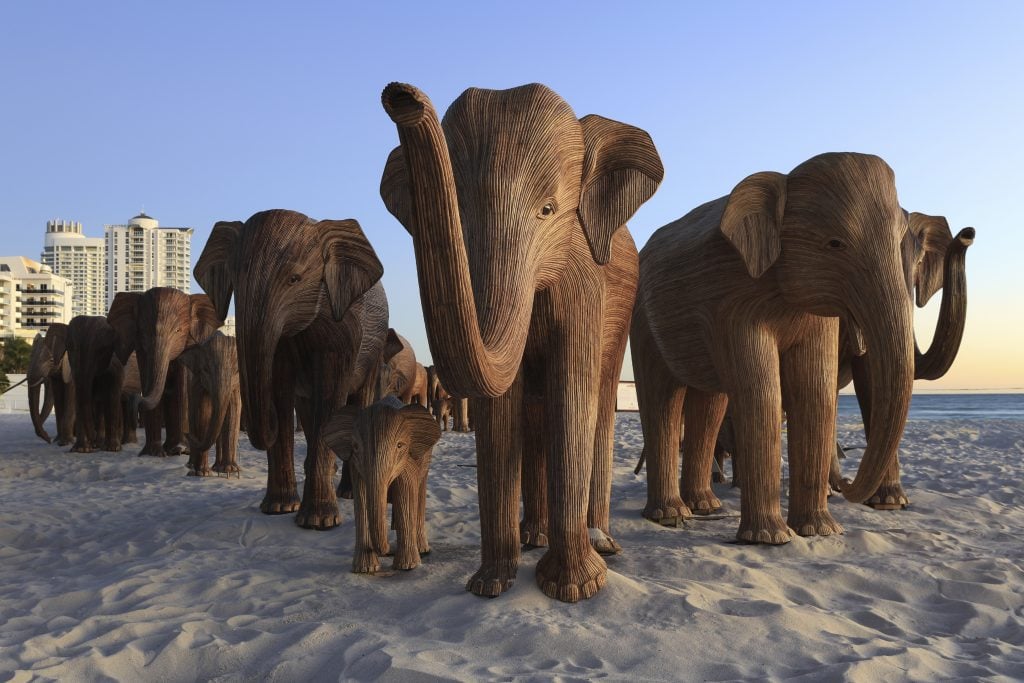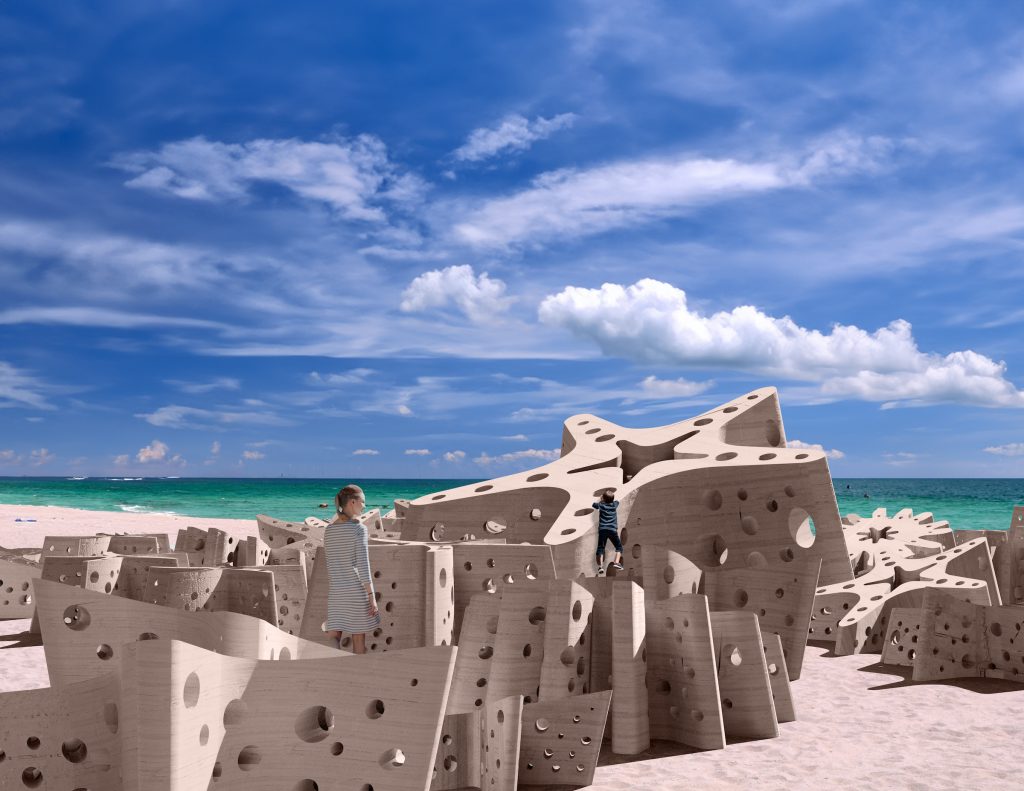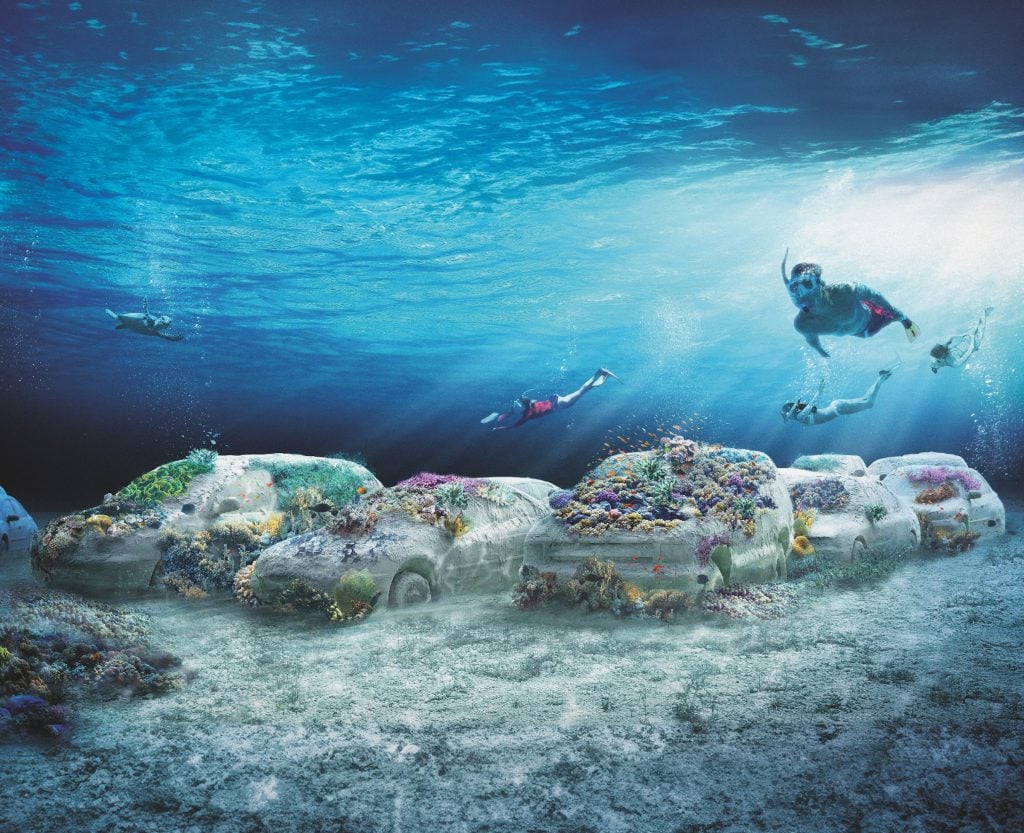
03 Dec A Herd of Massive Elephant Sculptures Migrates to Miami Beach
Source Credit: Content and images from Artnet News. Read the original article - https://news.artnet.com/art-world/elephant-sculptures-migrate-to-art-basel-miami-beach-2579113
For so many of us, the first week of December means a pilgrimage to Florida for Art Basel Miami Beach. But this year, a herd of 100 wooden elephants are joining the party, as the conservationist-minded “The Great Elephant Migration” has made its way to the sand.
The life-size sculptures are each modeled after an individual elephant, mostly from the Nilgiri Biosphere Reserve in South India. They are the handiwork of the Coexistence Collective, a group of 200 local Indigenous artisans. Designed by Shubhra Nayar, they are made from lantana camara, an invasive weed threatening to overtake the natural habitat of Indian elephants.
After kicking off their U.S. tour in Newport, Rhode Island, where the elephants roamed along the coastal cliffs near Gilded Age mansions, the herd spent much of the fall in Manhattan’s Meatpacking District, strolling the cobblestone streets. But they make an even more dramatic spectacle on the South Florida beach, set against the bright blue sky and sparkling teal waters.
“It’s so nice, people in bare feet with the herd,” Ruth Ganesh, the British animal rights activist behind the roving art project, told me. “And elephants are nature’s greatest masterpiece. They are like a Surrealist dream.”

“The Great Elephant Migration” in Miami Beach. Photo by Lee Smith.
So far, the reception has been enthusiastic—perhaps a little two enthusiastic. A breathless Page Six exclusive reported that a security guard caught a couple having sex on top of one of the elephants. There were no arrests made, but Miami Beach Police are now patrolling the installation, to ensure the thousands of visitors behave themselves.
“We knew that people would love them, but we didn’t think we’d take it that literally!” Ganesh said. “My question is how? They have very bony ridges on their backs!”
Ganesh launched the traveling art project as part of her work with the Real Elephant Collective, a nonprofit she started with elephant researcher and scientist Tarsh Thekaekara. All the elephant sculptures are for sale, with proceeds going to 22 partnering conservation non-governmental organizations, or NGOs—benefitting elephants, but also other species. The aim is to promote a mutually beneficial coexistence between humans and nature.

“The Great Elephant Migration” in Miami Beach. Photo by Lee Smith.
“I feel very proud of the indigenous creators for having captured Miami’s attention,” Ganesh said, noting that the collective is a well-paying job for a community that typically made low wages on nearby tea plantations. “Now there are 20 different villages with little workshops, and they’re all making elephants. And they know the elephants. These poor tribes actually know how to live with the elephants, and this rewards them for their ability to coexist.”
To date, 250 sculptures have already sold, staying behind as the herd has made its way down the East Coast. Prices range from $8,000 for a baby elephant to $22,000 for an adult males with tusks, which tops out at 15 feet tall. (Ganesh advises bringing the works indoors for the winter, but you can also cover them with a tarp.)
If you don’t have the space—indoor or out—for a life-size elephant, you can also support the cause by purchasing a bottle of the project’s signature scent. Coexistence, from Italian perfume house Xerjoff, costs €250 ($263) a bottle, with part of the proceeds going to the NGOs. The luxury brand is the sponsor for the Miami exhibition.

“The Great Elephant Migration” in Miami Beach. Photo by Lee Smith.
“The perfume has been made with flowers that you would find in an Indian elephant’s habitat, so you have notes of jasmine and damask rose,” Ganesh said.
(When I asked Sergio Momo, Xerjoff founder and creative director, if he was concerned that people might get confused and think that the perfume smelled like elephants, rather than their habitat, Momo told me King Charles made the same joke when the artwork was on view in London in 2021.)
In Miami, the elephants are also joined on the beach by a set of 46 3D-printed stars, laid out on the sand in a star-shaped formation. The artwork, titled Miami Reef Star, is the work of artist Carlos Betancourt and architect Alberto Latorre. It’s a prototype for an underwater sculpture that will be the first piece in the Reefline, a seven-mile artificial reef and sculpture park planned for Miami Beach.

Carlos Betancourt and Alberto Latorre, Miami Reef Star (2024), rendering. Image by Mateo Rembe, courtesy of the ReefLine.
When “The Great Elephant Migration” was planning its trip to Florida, the Reefline, which looks to restore Miami Beach’s decimated coral reefs, was a natural partner.
“We are about the water. They are about the land. And we’re both about preservation. So we decided to join forces,” Ximena Caminos, founder and artistic director of the Reefline, told me. (The overarching presentation, which also included a Daniel Buren regatta at the Pérez Art Museum Miami, is called “Star Compass.”)
The Reefline is being funded in part with a $5 million grant courtesy of Miami Beach taxpayers, who approved new arts and culture funding in 2022.
The first work, Concrete Coral by Leandro Erlich, is slated to be submerged 600 feet offshore, 20 feet below the waves, in spring 2025. The sculpture, of 22 cars, is a new take on the sandcastle traffic jam he created on the beach for Miami Art Week in 2019.

Leandro Erlich, Concrete Coral, rendering. Image courtesy of the ReefLine.
The individual arts of Miami Reef Star are designed to mimic the natural habitat of local fish, creating comforting nooks and crannies where they can relax, hidden from predators.
Both works will be made from CarbonXinc, a newly developed eco-friendly concrete, and will use Coral Lok technology, where lab-grown coral can be literally plugged into the art to kickstart the growth of the reef.

Carlos Betancourt and Alberto Latorre, Miami Reef Star (2024), rendering. Image by Mateo Rembe, courtesy of the ReefLine.
“We’re going to start with soft corals that are called gorgonians; these are kind of like sea fans that sway with the waves. It’s the dominant type of marine life you find in the couple of patches where there are still near-shore reefs in Miami,” marine biologist Colin Foord, founder of Coral Morphologic, the Miami multimedia aquaculture studio and science lab that will grow the coral, told me.
After the party wraps up in Miami Beach, “The Great Elephant Migration” will be back on the road. It will head to Hermann Park in Houston, Texas, in April; Blackfeet Nation in Browning, Montana in May; Jackson Hole, Wyoming, in June; and wrap up its journey in July in Los Angeles.
“The Great Elephant Migration” is on view on the beach between 36th and 37th Streets, Miami Beach, Florida, December 2–8, 2024.
Source Credit: Content and images from Artnet News. Read the original article - https://news.artnet.com/art-world/elephant-sculptures-migrate-to-art-basel-miami-beach-2579113

